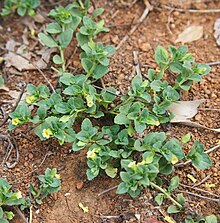
The Scrophulariaceae are a family of flowering plants, commonly known as the figwort family. The plants are annual and perennial herbs, as well as shrubs. Flowers have bilateral (zygomorphic) or rarely radial (actinomorphic) symmetry. The Scrophulariaceae have a cosmopolitan distribution, with the majority found in temperate areas, including tropical mountains. The family name is based on the name of the included genus Scrophularia L.

A savanna or savannah is a mixed woodland-grassland ecosystem characterised by the trees being sufficiently widely spaced so that the canopy does not close. The open canopy allows sufficient light to reach the ground to support an unbroken herbaceous layer consisting primarily of grasses.

Antirrhinum is a genus of plants commonly known as dragon flowers, snapdragons and dog flower because of the flowers' fancied resemblance to the face of a dragon that opens and closes its mouth when laterally squeezed. They are native to rocky areas of Europe, the United States, Canada, and North Africa. It is widely used as an ornamental plant in borders and as a cut flower.

Macadamia is a genus of four species of trees in the flowering plant family Proteaceae. They are indigenous to Australia, native to northeastern New South Wales and central and southeastern Queensland specifically. Two species of the genus are commercially important for their fruit, the macadamia nut. Global production in 2015 was 160,000 tonnes. Other names include Queensland nut, bush nut, maroochi nut, bauple nut and Hawaii nut. In Australian Aboriginal languages, the fruit is known by names such as bauple, gyndl or jindilli and boombera. It was an important source of bushfood for the Aboriginal peoples who are the original inhabitants of the area.
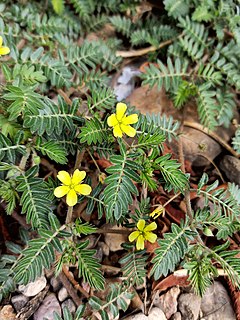
Tribulus terrestris is an annual plant in the caltrop family (Zygophyllaceae) widely distributed around the world. It is adapted to grow in dry climate locations in which few other plants can survive. It is native to warm temperate and tropical regions in southern Eurasia and Africa. It has been unintentionally introduced to North America and Australia. An aggressive and hardy invasive species, T. terrestris is widely known as a noxious weed because of its small woody fruit – the bur – having long sharp and strong spines which easily penetrate surfaces, such as bare feet or thin shoes of crop workers and other pedestrians, the rubber of bicycle tires, and the mouths and skin of grazing animals.
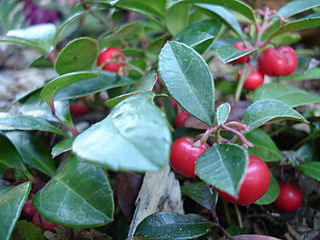
Gaultheria procumbens, also called the eastern teaberry, the checkerberry, the boxberry, or the American wintergreen, is a species of Gaultheria native to northeastern North America from Newfoundland west to southeastern Manitoba, and south to Alabama. It is a member of the Ericaceae.

Justicia is a genus of flowering plants in the family Acanthaceae. It is the largest genus within the family, encompassing around 700 species with hundreds more as yet unresolved. They are native to tropical to warm temperate regions of the Americas, India and Africa. The genus serves as host to many butterfly species, such as Anartia fatima. Common names include water-willow and shrimp plant, the latter from the inflorescences, which resemble a shrimp in some species. The generic name honours Scottish horticulturist James Justice (1698–1763). They are closely related to Pachystachys.

Pandanus tectorius is a species of Pandanus (screwpine) that is native to Malesia, eastern Australia, and the Pacific Islands. It grows in the coastal lowlands typically near the edge of the ocean. Common names in English include thatch screwpine, Tahitian screwpine, hala tree and pandanus. The edible fruit is sometimes known as hala fruit.

Bacopa is a genus of 70–100 aquatic plants belonging to the family Plantaginaceae. It is commonly known as waterhyssop.
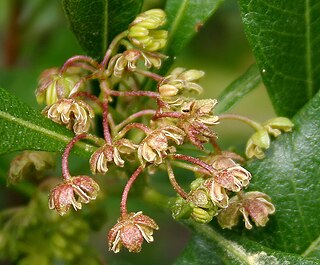
Dodonaea viscosa is a species of flowering plant in the Dodonaea (hopbush) genus that has a cosmopolitan distribution in tropical, subtropical and warm temperate regions of Africa, the Americas, southern Asia and Australasia. Dodonaea is part of Sapindaceae, the soapberry family.

Intsia bijuga, commonly known as Borneo teak, Johnstone River teak, Kwila, Moluccan ironwood, Pacific teak, scrub mahogany and vesi, is a species of flowering tree in the family Fabaceae, native to the Indo-Pacific. It ranges from Tanzania and Madagascar east through India and Queensland, Australia, Papua New Guinea to the Pacific islands of Fiji and Samoa.It grows to around 50 metres tall with a highly buttressed trunk. It inhabits mangrove forests. Intsia bijuga differ from Intsia palembanica in the number of leaflets that make up their compound leaves.

Azolla filiculoides is a species of Azolla, native to warm temperate and tropical regions of the Americas which was introduced to Europe, North and sub-Saharan Africa, China, Japan, New Zealand, Australia, the Caribbean and Hawaii.

Tridax procumbens, commonly known as coatbuttons or tridax daisy, is a species of flowering plant in the family Asteraceae. It is best known as a widespread weed and pest plant. It is native to the tropical Americas, but it has been introduced to tropical, subtropical, and mild temperate regions worldwide. It is listed as a noxious weed in the United States and has pest status in nine states.
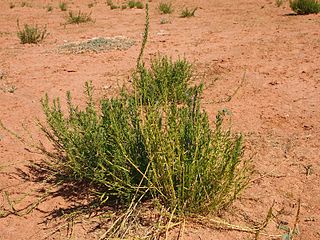
Stemodia is a genus of flowering plants in the family Plantaginaceae. The genus comprises approximately 40 species of annual and perennial herbs and shrubs which are distributed throughout temperate and tropical regions of Asia, Africa, Australia and the Americas. This genus is sometimes placed in the families Scrophulariaceae or Gratiolaceae. The generic name is derived from the Latin word stemodiacra, which means "stamens with two tips." Twintip is a common name for several species.

Tetrachondraceae is a flowering plant family in the order Lamiales. The family contains the two genera Polypremum and Tetrachondra which together comprise the three species:

A pitaya or pitahaya is the fruit of several different cactus species indigenous to the Americas. Pitaya usually refers to fruit of the genus Stenocereus, while pitahaya or dragon fruit refers to fruit of the genus Selenicereus, both in the family Cactaceae. Dragon fruit is cultivated in Peru, Mexico, South Asia, Southeast Asia, East Asia, the United States, the Caribbean, Australia, Mesoamerica and throughout tropical and subtropical regions of the world.

Asarina is a flowering plant genus of only one species, Asarina procumbens Mill. the trailing snapdragon, which is native to France and Spain and introduced in Germany, Switzerland, Austria and Hungary. Originally placed in the Scrophulariaceae, the genus has more recently been moved to the Plantaginaceae. Species from North America formerly placed in the genus Asarina are now placed in Holmgrenanthe, Lophospermum, Mabrya and Maurandya, as well as Neogaerrhinum. Asarina is now regarded as exclusively an Old World genus.
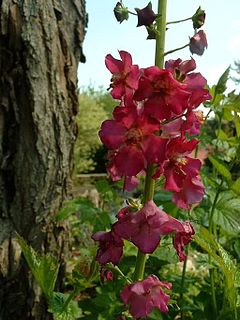
Verbascum phoeniceum, known as purple mullein, is a species of mullein that is part of the family Scrophulariaceae native to Central Europe, Central Asia and Western China. It is also naturalized in certain regions of the US and Canada. It successfully grows in USDA’s zones 4 to 8. It is a short-lived perennial species, and blooms earlier than other mullein species on average, producing vibrant purple-pink flowers; it can grow up to 1m or more.

Polypremum is a flowering plant genus in the family Tetrachondraceae. The genus contains the single species Polypremum procumbens, commonly known as juniperleaf or rustweed. Polypremum has also been placed in the various families Buddlejaceae, Loganiaceae, Rubiaceae, and most recently in its own Polypremaceae.
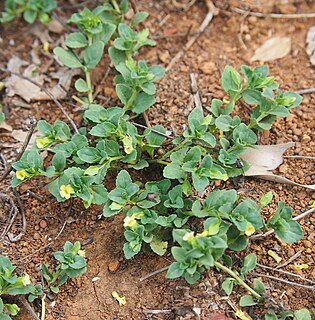
Mecardonia (axilflower) is a genus of herbaceous plants in the family Plantaginaceae. 31 species have been described, of which 12 are accepted. Its distribution is predominantly in South America, and South East United States, including Florida and Alabama but may be found as far north as Virginia. (see map) Five species are found in Argentina and three in the US.
